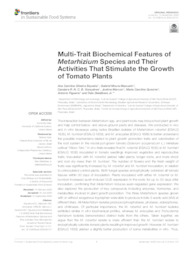Multi-trait biochemical features of Metarhizium species and their activities that stimulate the growth of tomato plants.
Multi-trait biochemical features of Metarhizium species and their activities that stimulate the growth of tomato plants.
Autoria: SIQUEIRA, A. C. O.; MASCARIN, G. M.; GONÇALVES, C. R. N. C. B.; MARCON, J.; QUECINE, M. C.; FIGUEIRA, A.; DELALIBERA JUNIOR, Í.
Resumo: Abastract: The interaction between Metarhizium spp. and plant roots may induce host plant growth and help control below- and above-ground pests and diseases. We conducted in vivo and in vitro bioassays using native Brazilian isolates of Metarhizium robertsii (ESALQ 1635), M. humberi (ESALQ 1638), and M. anisopliae (ESALQ 1669) to better understand the possible mechanisms related to plant growth promotion traits and colonization of the root system in the model pot-grown tomato (Solanum lycopersicum L.) miniature cultivar ?Micro-Tom.? In vivo trials revealed that M. robertsii (ESALQ 1635) or M. humberi (ESALQ 1638) inoculated in tomato seedlings improved vegetative and reproductive traits. Inoculation with M. robertsii yielded taller plants, longer roots, and more shoot and root dry mass than M. humberi. The number of flowers and the fresh weight of fruits was significantly increased by M. robertsii and M. humberi inoculation, in relation to uninoculated control plants. Both fungal species endophytically colonized all tomato tissues within 30 days of inoculation. Plants inoculated with either M. robertsii or M. humberi increased auxin-induced GUS expression in the roots for up to 30 days after inoculation, confirming that Metarhizium induces auxin-regulated gene expression. We also explored the production of key compounds including enzymes, hormones, and metabolites involved in plant growth promotion. The three Metarhizium species grown with or without exogenous tryptophan were able to produce indole-3-acetic acid (IAA) at different titers. All Metarhizium isolates produced phosphatases, phytases, siderophores, and chitinases. Of particular importance, the M. robertsii and M. humberi isolates exhibited similar in vitro biochemical profiles, whereas M. anisopliae and Trichoderma harzianum isolates demonstrated distinct traits from the others. Taken together, we argue that the M. robertsii isolate is more efficient than the M. humberi isolate to endophytically colonize tomato plants resulting in improved growth. However, M. humberi (ESALQ 1638) yielded a slightly better production of some metabolites in vitro. Thus, we propose that the isolates of M. robertsii and M. humberi could be explored as complementary plant growth promoters.
Ano de publicação: 2020
Tipo de publicação: Artigo de periódico
Unidade: Embrapa Meio Ambiente
Palavras-chave: Estimulante de Crescimento Vegetal, Fungo Entomógeno, Phosphate solubilization, Tomate
Observações
1 - Por padrão são exibidas publicações dos últimos 20 anos. Para encontrar publicações mais antigas, configure o filtro ano de publicação, colocando o ano a partir do qual você deseja encontrar publicações. O filtro está na coluna da esquerda na busca acima.
2 - Para ler algumas publicações da Embrapa (apenas as que estão em formato ePub), é necessário ter, no celular ou computador, um desses softwares gratuitos. Sistemas Android: Google Play Livros; IOS: iBooks; Windows e Linux: software Calibre.
Acesse outras publicações
Acesse a Base de Dados da Pesquisa Agropecuária (BDPA) para consultar o acervo completo das bibliotecas da Embrapa.

